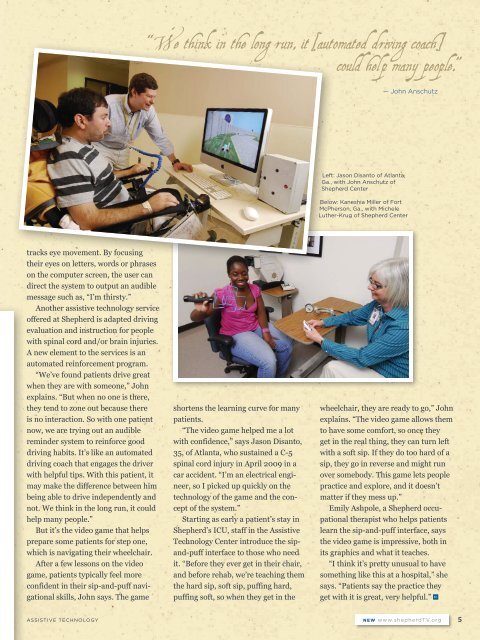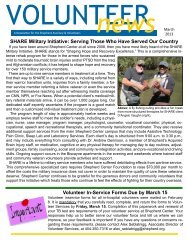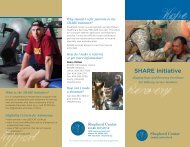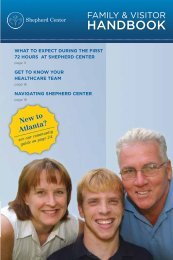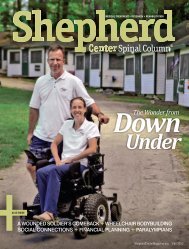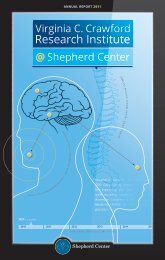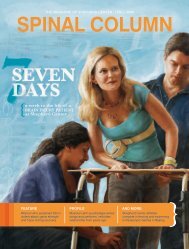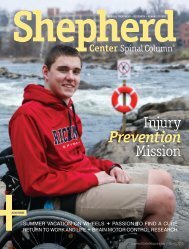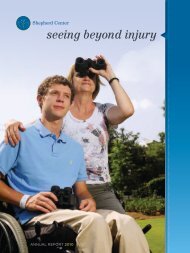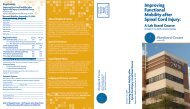Reviewers from The Joint Commission recently ... - Shepherd Center
Reviewers from The Joint Commission recently ... - Shepherd Center
Reviewers from The Joint Commission recently ... - Shepherd Center
- No tags were found...
Create successful ePaper yourself
Turn your PDF publications into a flip-book with our unique Google optimized e-Paper software.
“We think in the long run, it [automated driving coach ]could help many people.”— John AnschutzLeft: Jason Disanto of Atlanta,Ga., with John Anschutz of<strong>Shepherd</strong> <strong>Center</strong>Below: Kaneshia Miller of FortMcPherson, Ga., with MicheleLuther-Krug of <strong>Shepherd</strong> <strong>Center</strong>tracks eye movement. By focusingtheir eyes on letters, words or phraseson the computer screen, the user candirect the system to output an audiblemessage such as, “I’m thirsty.”Another assistive technology serviceoffered at <strong>Shepherd</strong> is adapted drivingevaluation and instruction for peoplewith spinal cord and/or brain injuries.A new element to the services is anautomated reinforcement program.“We’ve found patients drive greatwhen they are with someone,” Johnexplains. “But when no one is there,they tend to zone out because thereis no interaction. So with one patientnow, we are trying out an audiblereminder system to reinforce gooddriving habits. It’s like an automateddriving coach that engages the driverwith helpful tips. With this patient, itmay make the difference between himbeing able to drive independently andnot. We think in the long run, it couldhelp many people.”But it’s the video game that helpsprepare some patients for step one,which is navigating their wheelchair.After a few lessons on the videogame, patients typically feel moreconfident in their sip-and-puff navigationalskills, John says. <strong>The</strong> gameshortens the learning curve for manypatients.“<strong>The</strong> video game helped me a lotwith confidence,” says Jason Disanto,35, of Atlanta, who sustained a C-5spinal cord injury in April 2009 in acar accident. “I’m an electrical engineer,so I picked up quickly on thetechnology of the game and the conceptof the system.”Starting as early a patient’s stay in<strong>Shepherd</strong>’s ICU, staff in the AssistiveTechnology <strong>Center</strong> introduce the sipand-puffinterface to those who needit. “Before they ever get in their chair,and before rehab, we’re teaching themthe hard sip, soft sip, puffing hard,puffing soft, so when they get in thewheelchair, they are ready to go,” Johnexplains. “<strong>The</strong> video game allows themto have some comfort, so once theyget in the real thing, they can turn leftwith a soft sip. If they do too hard of asip, they go in reverse and might runover somebody. This game lets peoplepractice and explore, and it doesn’tmatter if they mess up.”Emily Ashpole, a <strong>Shepherd</strong> occupationaltherapist who helps patientslearn the sip-and-puff interface, saysthe video game is impressive, both inits graphics and what it teaches.“I think it’s pretty unusual to havesomething like this at a hospital,” shesays. “Patients say the practice theyget with it is great, very helpful.”assistive technologyn e w www.shepherdTV.org5


